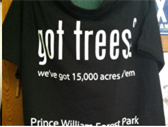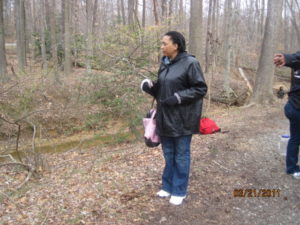By Elizabeth Rives, Bridging the Watershed Program Coordinator

“Look at that – that tree is tight!” exclaimed a bubbly six-grader from Accokeek Academy while walking to the site for a Bridging the Watershed field study. Fortunately, I’ve hung around enough tweeners and teenagers to know that tight, in teen-speak, means “stylish, cool, having everything together,” according to the web-based Urban Dictionary. The student was admiring the striking white silhouette of an American sycamore tree on the banks of the Chesapeake & Ohio Canal National Historical Park at Great Falls Tavern.
At BTW we thrive on those “aha” moments when learning becomes relevant, or “tight,” to a student’s life. We’ve become accustomed to hearing such exclamations over a crayfish, or an especially large and menacing hellgrammite the students have netted in the creek. Sometimes the awe is even over chemistry when a water sample magically turns from dark blue to clear. But it’s not often about a tree. So for me, a devoted tree enthusiast and tree identification teacher, I couldn’t believe my ears when it was a tree that inspired that level of enthusiasm.

And then, to my delight, it happened again the next week at Prince William Forest Park — a park whose main claim to fame is 15,000 acres of trees. All those tree roots soak up pollutants from runoff before the water drains into Quantico Creek, making it one of the most pristine streams in the greater Washington, DC metropolitan region. For BTW students, that means a boundless diversity of insects to study. For one North Stafford High School AP Environmental Science student, however, it sparked an unsolicited and lengthy private discussion with me about non-native trees and their impact on the surrounding ecology! Now that was perhaps as thrilling an “aha” moment for me, the educator, as it was for the student.

Four days later at BTW’s advanced teacher workshop on benthic macroinvertebrates I got my third tree “aha” in three weeks. This time it came from a teacher who, at the end of the workshop, suddenly remembered she knew me from a workshop on tree identification I led the previous summer at, where else?, Prince William Forest Park. To my surprise, amusement, and embarrassment, her face lit up as she shouted, “Oh, you’re the tree lady,” toward the end of my talk on field logistics. Okay, so maybe this one wasn’t so much about trees, but at least she had associated me with trees and remembered that she had taken a workshop to learn how to identify them.
If you’re wondering what my take away was from that flurry of tree “aha” moments, that’s easy: all good things come in trees, er threes.

